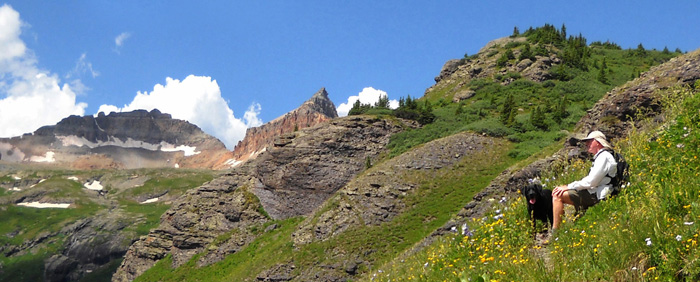What a difference a few decades make!
Old Colorado City is the
oldest city in the Pike's Peak Region.
Established in 1859, and designated the first capitol of the Colorado
Territory in 1861, it was annexed to Colorado Springs in 1917 and
restored as the city's only National Historic District in 1977.
Several blocks of Old Colorado City are now a very desirable place to live on the west side of Colorado Springs.
People who own the historic homes are obviously proud of their neighborhood, if the
condition of most of the houses and yards are any indication:
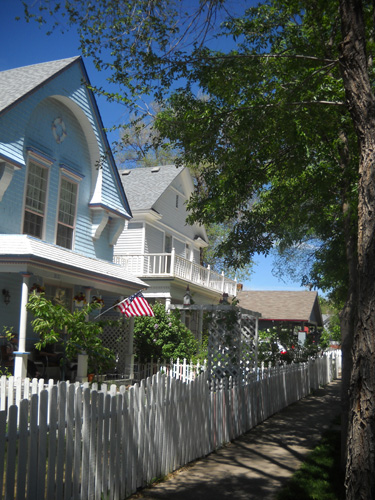
I've enjoyed a couple of walks and drives through the area, taking
photos of some of the interesting older houses. Many of them are Victorian
designs from the 1800s.
We noticed American flags displayed on most the houses to commemorate
Memorial Day weekend:
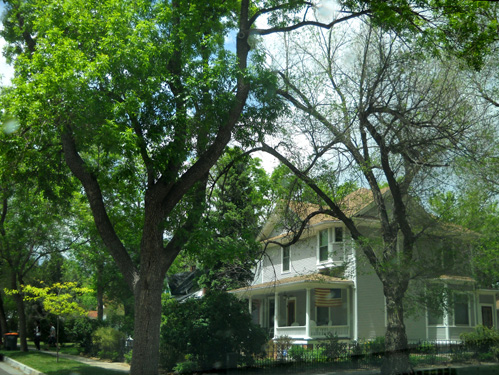
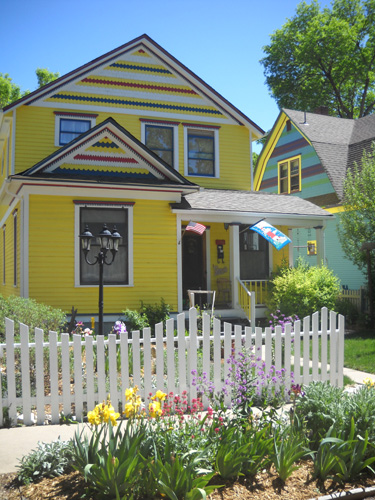
Some of the old 19th Century retail buildings also still exist on
and near Colorado Avenue between 24th and 28th Streets. They house specialty
shops, restaurants, art galleries, and other businesses.
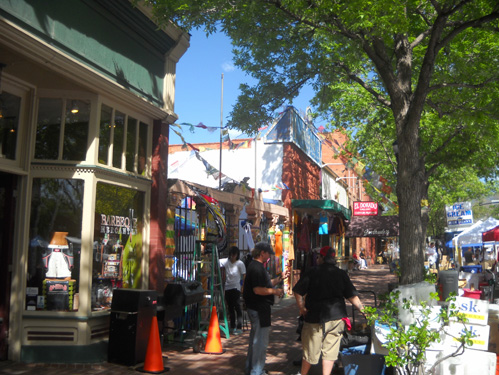
This is the
cornerstone of one that was built in 1889:
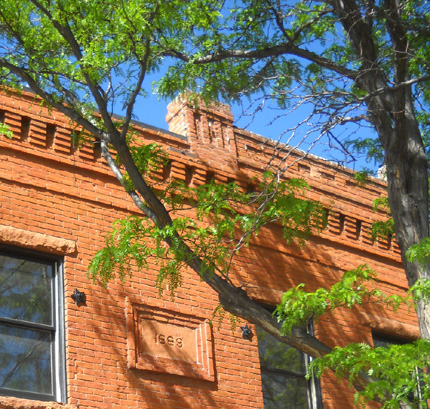
I especially like the name of this establishment (Meadow Muffins), its architecture, and
the realistic trompe l'oeil painting
of a man in the second-story window of this building:
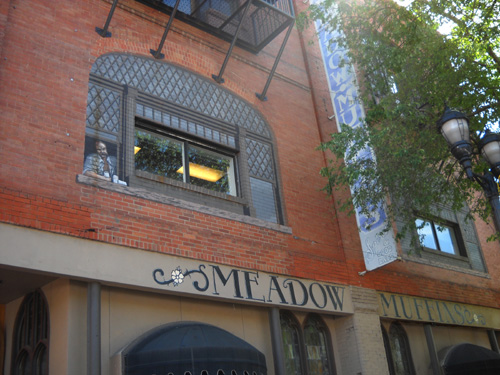
What's here now is a far cry from the saloons and brothels that used to
line this street.
LET'S CELEBRATE!
One way Old Colorado City tries to preserve pieces of its past (such as
19th Century farm and ranch life, local industries and
businesses that outfitted and entertained the folks
heading farther west for the gold boom and silver rush, mills to process
the ores, the railroad, destructive fires, wars with Native American
Indians, schools and libraries, high society balls, etc.) and
help to ensure its economic future is to
sponsor various events throughout the year that entice visitors
to come and spend their money in a fun atmosphere -- art walks, music
and dancing in Bancroft Park, car shows. food festivals, and special
holiday events at Christmas, Halloween, Labor Day, and Easter.
Probably the largest event is the annual Territory Days festival on
Memorial Day Weekend. When the weather is good, as it is this weekend, the
three-day event typically attracts over 100,000 people.
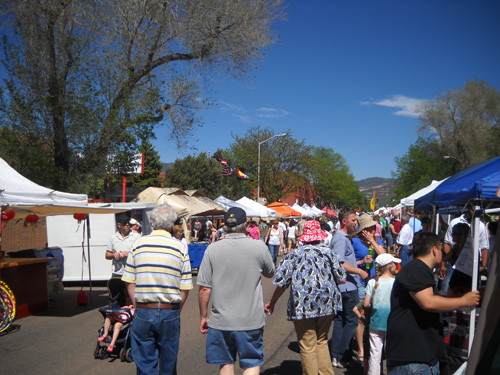
This is the 35th year for the street festival, which has a wide variety
of activities, arts and crafts, historical displays, and music for
people of all ages.
Entry is free, although some optional participatory activities charge a
fee, such as pony rides, mechanical bull rides, and a climbing wall.
Other activities like gold panning (below), kids' train rides, and music
on the street and in the Bancroft Park band shell are free.
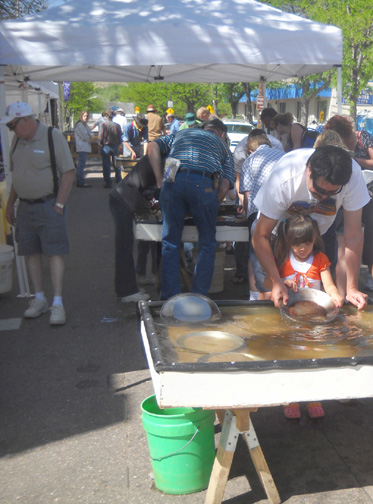
Some of this year's special events include a Memorial Day Moment of
Silence for fallen war heroes, fast-draw competitions, Old West skits
and gunfights, birds of prey demonstrations, actors dressed in period
clothing wandering through the crowd,
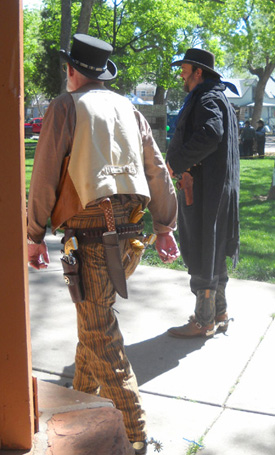
volunteers dispensing area lore at
the historic Garvin cabin and the Old Colorado City Historical Society
tent, and blacksmiths demonstrating their craft. Visitors could also
check out authentic Indian tipis, a chuck wagon, and historic photos.
Most of the businesses on the street remained open during the festival.
The OK Corral Saloon and other restaurants seemed to be doing great,
even in mid-morning. When Jim got tired of looking at the street
vendors, he sat in a shady spot next to this busy cafe for a few
minutes:
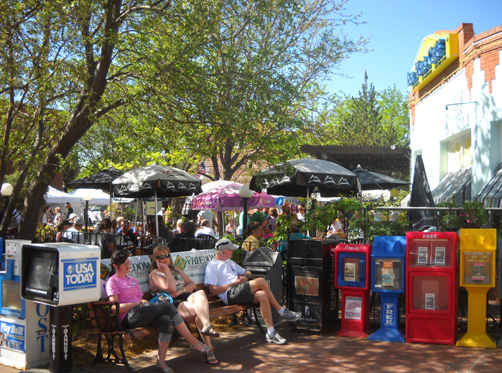
We thought it'd be pretty cool to check the festival out. I mean, it's
free and it wasn't much of a drive. How could we go wrong? Some of these events can be really
fun. Our idea of what was fun was probably different from what
the majority of the other visitors thought was fun, however.
We kind of knew what to
expect from the promotional literature we'd picked up. We knew one thing for
sure: we needed to arrive early to avoid the heat and largest
crowds, and to get a decent free parking
space along the street. We didn't want to ride a shuttle, and some businesses
and churches were charging folks $10 to park closer to the festival.
The festival was advertised as open from 10-7 today. We got there about
9:15 and scored a nice, shady, *free* parking spot on a side street a
couple blocks from one end of the area closed off for the booths on Colorado
Avenue. We wandered over to the festival area even though we were early, just
to see what was going on.
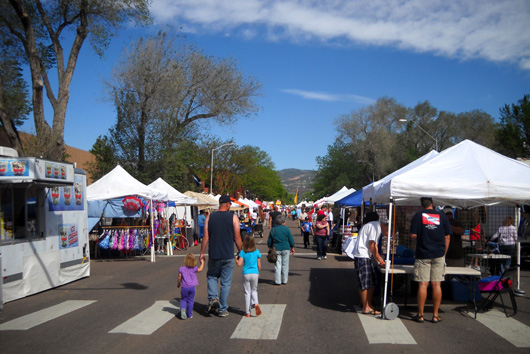
Sparse crowd before the official opening time
Most of the vendors already had their booths set up and were ready for
early birds like us -- kinda like at yard sales, where sellers know some
folks want to be the first ones there for the best pickings!
About 200 street vendors stretched four blocks up Colorado Avenue. Some of
the booths surprised us. There were a lot of crafts but very little of what I'd
consider art. That disappointed me a bit.
About a third of the booths offered food, mostly
over-priced and totally decadent items like huge deep-fried turkey legs and sugary
funnel cakes. This one amused us:
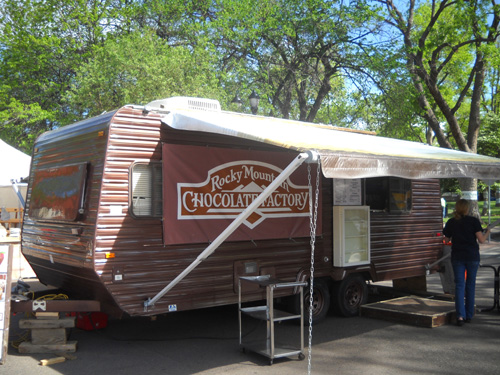
The trailer looks like it's been dipped in chocolate!
We
thought we struck gold when we found a booth with homemade baked goods;
we bought a loaf of delicious basil/asiago cheese bread to nibble on as we
walked around the festival and enjoyed the rest of it later with meals. That's
the one and only thing we bought today.
What surprised us the most about the displays were all the
commercial vendors who had booths, ones we've never seen at a festival
before -- Direct TV, phone companies, Andersen Windows, Subaru, even
Home Depot!!
But it was one of the commercial vendors, a small businessman, whose booth
we liked the best:
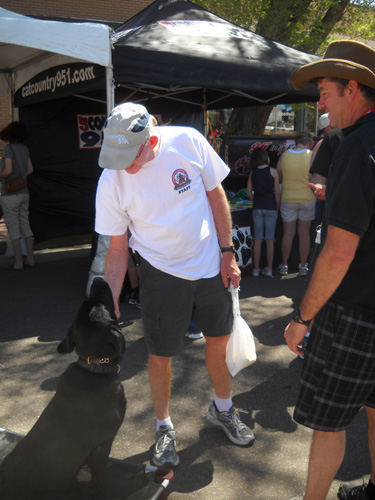
Jim pets a well-behaved Cody look-alike at the "Sit Means
Sit!" booth.
Dogs were not allowed into the festival area so we were a little
surprised when we came to a booth with both a black Lab (a dead ringer for
Cody) and a standard poodle,
each sitting perfectly still on its own little trampoline as hundreds of people
walked by and/or petted them. The booth was manned
by the man who runs a dog training business called "Sit Means Sit!" It was fun
to pet the pooches and talk to the trainer.
Now there's a job Cody would love!
The Air Force Academy had a strong presence at the festival, which was
appropriate on Memorial Day weekend. Several officers and cadets manned
their display in the large Bancroft Park shelter (below). We saw lots of
visitors go inside to pick up literature and learn more about the
Academy.
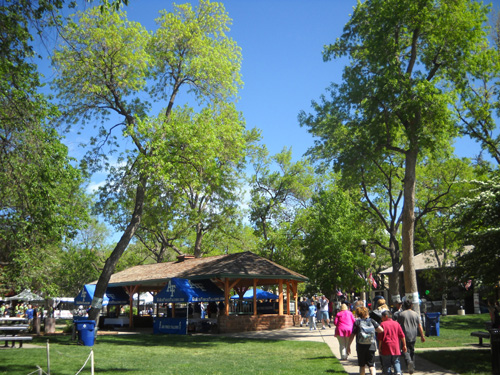
I just happened to be nearby when I saw a military salute in the nearby band
shell; I didn't see it listed in the program.
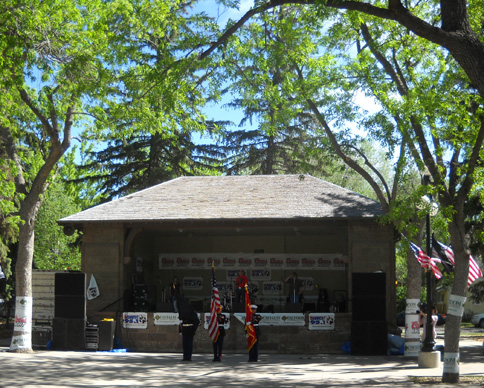
We enjoyed the historical activities and demonstrations the most, especially
those presented by costumed volunteers from Rock Ledge Ranch and the Old Colorado City Historical
Society:
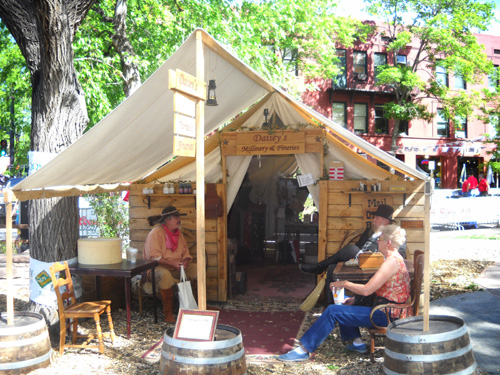
There were several signs erected in the park with old photographs and
information about life in the area in the late 1800s, when Old Colorado City was a natural stopping and re-supply center for the gold (and silver and lead)
rush towns to the west.
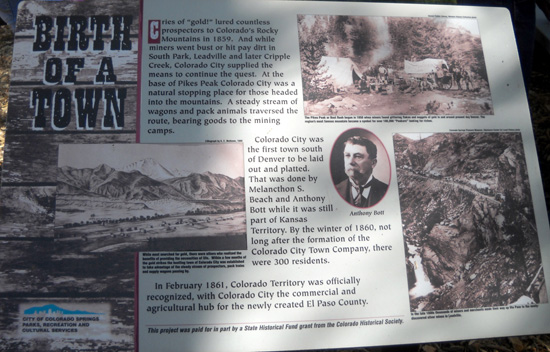
The photo in the lower right corner of the sign above just flips me out.
Here's an enlargement:
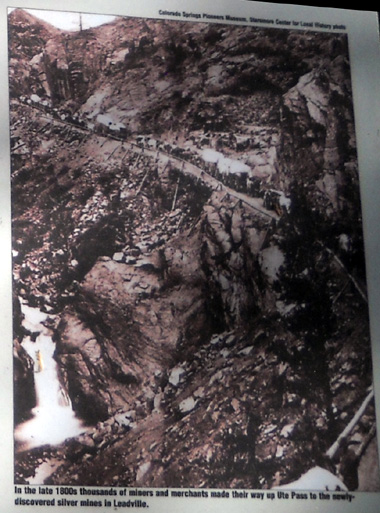
I realize it's hard to see, but it shows miners and merchants in wagons
heading to the Leadville silver mines in the late 1800s on a very narrow,
wooden "road" dangling precariously on the side of a cliff at Ute Pass.
It's worth a trip to the Colorado Springs Pioneer Museum to see it up close!
Jim and I often marvel at the remains of mines and related buildings we see
perched on sheer cliffs at 10,000 and 12,000 feet in the air near Silverton and
Leadville and Cripple Creek and other Colorado mining areas. This is as
death-defying as that boarding house high above Cunningham Gulch near
Silverton! If you've ever been to the Hardrock Hundred ultra marathon, you
probably know what I'm talking about.
Those were some tough hombres.
Another interesting exhibit we enjoyed was the blacksmith demonstration in
the park. Two smithies who work at the Rock Ledge Ranch Historic Site displayed items they and fellow craftsmen have made
and showed how it's done:
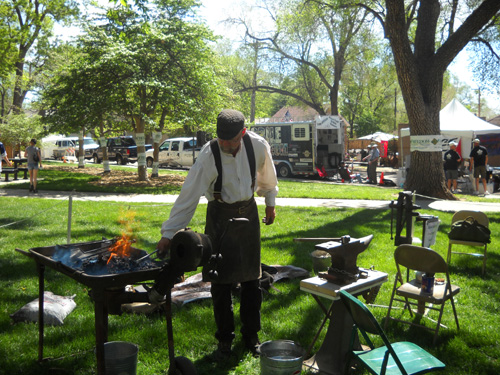
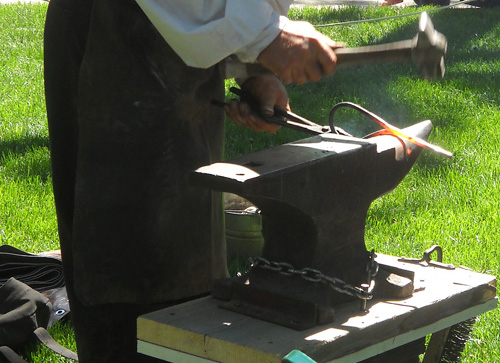
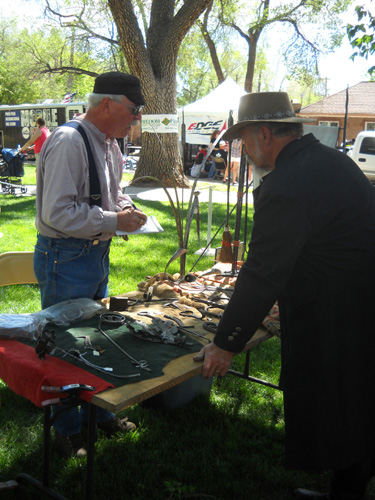
We watched the blacksmiths for about ten minutes, then headed across the street to
visit the Old Colorado City History Center.
THE HISTORY CENTER
While most festival-goers were enjoying the vendors' booths, musical
entertainment, gold panning, beer, and BBQ, Jim and I were more interested in
the historical aspects of Territory Days. We spent as much time in the
History Center, Garvin cabin, Old West camp store, and blacksmithing area as we did wandering around
the street festival.
Different strokes.
The History Center is a non-profit
organization operated by volunteers of the Old
Colorado City Historical Society. The museum is housed in a former Baptist
church on 24th Street that was originally built in 1890. Architect Walter E.
Douglas also designed other churches, houses, and buildings in Old Colorado
City.
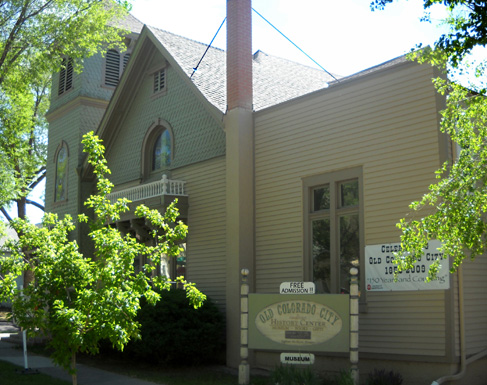
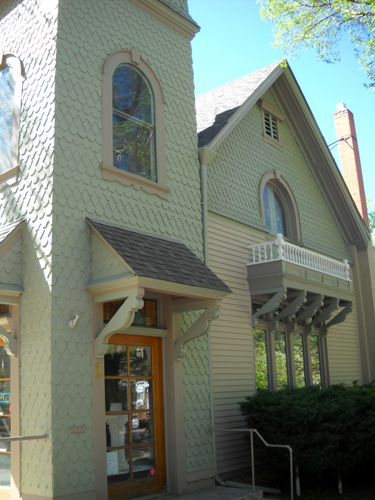
The Historical Society bought the church building in 1992 and renovated it
into a bright, airy space for the History Center. It is open to the public Tuesday through Saturday
from 11-4. Admission is free.
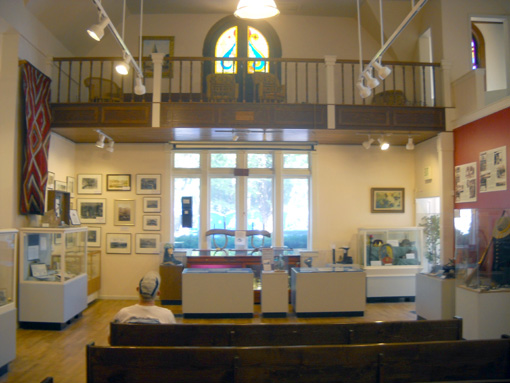
The History Center has numerous displays and photos of 19th and 20th Century life in
the Old Colorado Springs area.
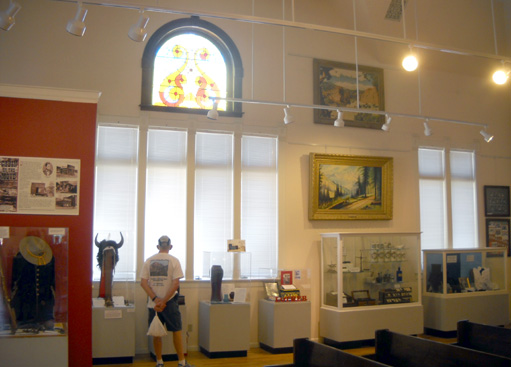
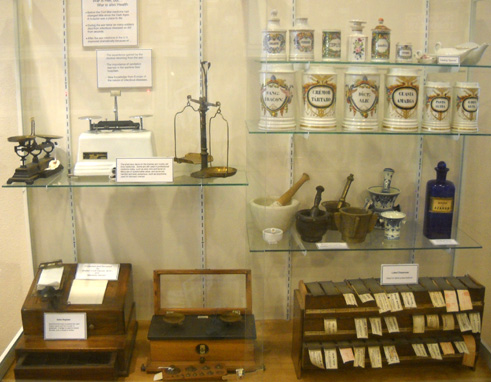
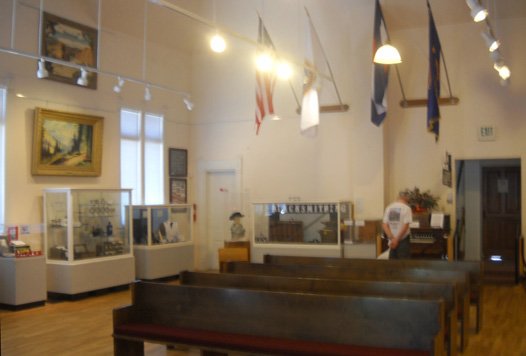
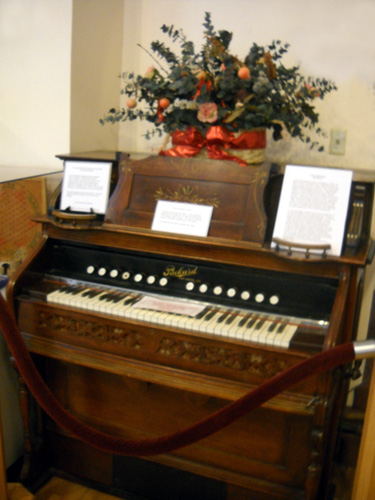
Exhibits include hand-blown (and later, mass-produced) glass
bottles for mineral water, liquor, wine, and beer made in the
area, photos of the gold ore reduction mills, post-Civil War
medical supplies,
information about the cog railway on nearby Pike's Peak, and
many other subjects.
One of the more interesting displays describes how folks, mostly
railroad employees, used to descend the cog railway from the top
of Pike's Peak down to Manitou Springs on flat rocks, homemade
"toboggans," or other rickety (and risky) contraptions.
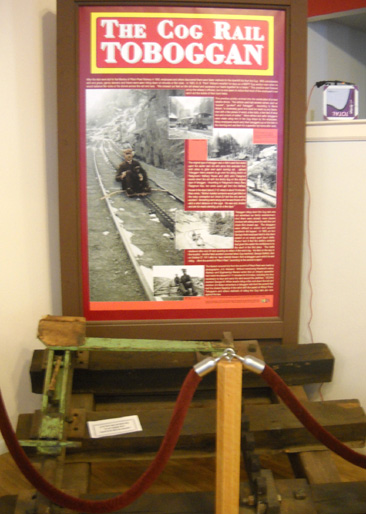
This is part of the narrative on the display: "After
the rails were laid for the Manitou & Pike's Peak Railway in
1890, employees and others discovered there were faster ways for
the downhill trip than the Cog . . . The practice was frowned on
by the railway's officials . . ."
. . . but no one seemed to notice that the more reliable
toboggans were being built by railroad employees with iron and
other materials found in their shop! Early seats were flat rocks
or shovels. Soon crafty guys were making sleds from "a few
pieces of wood, a few bolts, a few feet of strap iron, and a
hunk of rubber."
"Many employees would carry their toboggans up on the train in
the morning and use them for a speedier trip home after work."
This is one of the photos in the display. It shows John
Palsgrove and his dog on one of the original types of toboggan.
Palsgrove ran the "halfway" house on the mountain; there's still
a halfway house on the road up the mountain but I don't know if
Palsgrove's building was in the same place. He rode his sled
from the halfway house down to the depot in Manitou Springs after work, reportedly
taking about ten minutes to ride 2½
miles:
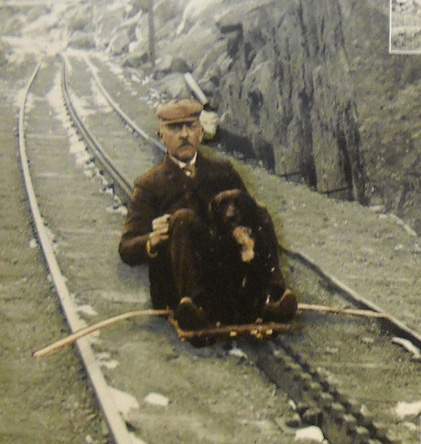
The rumored speed record (you know someone had to be the
fastest!) to descend the
almost-nine miles of rail via toboggan -- including the
time necessary to carry his sled over the switches at the
halfway house
-- was 11 minutes by a photographer named J.G. Hiestand.
Do the math. We figure that's almost 50 MPH descending 7,000+ feet on a
piece of wood on bumpy iron cogsl!!
Good grief! When you read about the difficulty of controlling
the toboggans -- let alone the other less sophisticated devices used as seats
--
and the resultant accidents, injuries, and even deaths that
occurred before the practice was banned, you can only marvel at
the guy's speed. (He lived to brag about it.) Most folks went slower than that but it was
still a risky venture.
Sure sounds like fun, though, doesn't it?? I think that exhibit
alone was worth visiting the History Center!
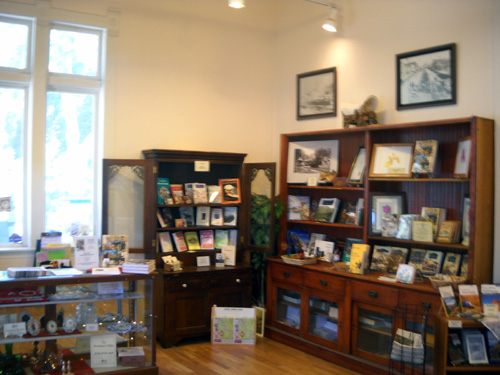
In addition to the artifacts, photos, and written information in the
displays, the History Center has a corner (above) in another room with
lots of interesting history books for perusal or purchase.
I could have
spent a lot more time in the museum, but as you can see in one of the photos
above, Jim maxed out before I did and had a seat in the front pew
while waiting for me.
Maybe I'll just go back the next time we're in Colorado Springs and read
some more historical anecdotes
. . .
Next entry: exploring the USAF Academy's 19,000 acres via
the Falcon Loop Trail
Happy trails,
Sue
"Runtrails & Company" - Sue Norwood, Jim O'Neil,
and Cody the Ultra Lab
Previous
Next
© 2010 Sue Norwood and Jim O'Neil
